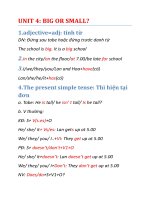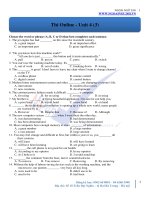online unit 4 opinion essays slides
Bạn đang xem bản rút gọn của tài liệu. Xem và tải ngay bản đầy đủ của tài liệu tại đây (392.86 KB, 17 trang )
Writing 2
Unit 4: Opinion Essays
Unit 5: Comparison and Contrast Essays
Unit 6: Cause and Effect Essays
WRITING 2
UNIT 4: OPINION ESSAYS
OPINION ESSAYS: Purpose
• To persuade the reader of a point of view on a controversial issue
OPINION ESSAYS: Three-paragraph Format
1 paragraph
•
Introduction
1 paragraph
•
Body
1 paragraph
•
Conclusion
INTRODUCTION: Structure
INTRODUCTION
introduces the issue = telling short story/asking
question/giving surprising fact to attract reader’s
gives more details : why the issue is important
presents writer’s point of view
interest
HOOK
BACKGROUND INFORMATION
THESIS STATEMENT
INTRODUCTION: Example (Savage & Mayer, 2006)
Last week, I noticed that my son had a bad cold. I took him to the pediatrician, and she told me he had
an infection. Then she gave me a prescription for antibiotics. After two days, my son was happy and healthy
thanks to this important medicine (hook: telling a short story). Every day doctors prescribe antibiotics to help
thousands of patients around the world fight infections (background information: explaining why antibiotics are important). I
do not like to think about what might happen if we did not have antibiotics (thesis statement: supporting the use of
antibiotics).
BODY PARAGRAPH: Structure
Topic sentence
conveys main idea that supports 1 point of view in thesis statement
Following sentences
support topic sentence = reasons; facts; examples; explanations
Counter argument
describes opposing opinion
Refutation
points out weaknesses in counter-argument & shows strengths of writer’s argument
BODY PARAGRAPH: Example
(Savage & Mayer, 2006)
Antibiotics are one of the greatest medical inventions in human history for several reasons (topic sentence). First, infections are
frequent. Almost everyone has experienced an ear infection or a sinus infection. These common illnesses cause pain and discomfort to
millions of people around the world every year. In addition, infections can be life-threatening. For example, sepsis, a dangerous infection of
the blood, is responsible for one out of every one hundred hospitalizations. The victims are usually very young, old, or weak. Another
reason why antibiotics are important is that they stop an infection from spreading to others. Infectious diseases can quickly travel from
person to person if they are not treated right away. Antibiotics are the most effective way to control the spread of these serious illnesses.
Recently, many people have argued that doctors prescribe antibiotics too often and that the bacteria that cause infections are becoming
stronger as a result (counter-argument). This may be true; however, this evidence does not mean that antibiotics are not important. It simply
shows that we must learn to use them wisely (refutation).
CONCLUSION: Structure
• Conclusion = writer’s opinion + warning/prediction/advice
CONCLUSION: Example
(Savage & Mayer, 2006)
Infections can attack anyone at any time. They can also attack entire populations. While many infections
create minor discomfort and suffering, some are quite dangerous (summary of reasons). Antibiotics are the most
effective way to treat infections (thesis restatement). Without antibiotics, many more people would get seriously
ill, and others would die (a warning).
OPINION ESSAYS: Writing task
Write a three-paragraph essay to show your opinions on the following comment:
“Attendance at college classes should be optional.”
STEP 1: Brainstorming ideas
Agree
Opinion
“Attendance at college classes should
be optional.”
Disagree
STEP 2: Outlining
Introduction
Body
Conclusion
Hook:
Topic sentence: _____________________
Summary and comment:
_____________________________________
Examples/reasons:
_____________________________________
_____
_____________________________________
__________________________
Background information:
_____
_____________________________________
Counter-argument:
_____
_____________________________________
Thesis statement:
_____
_____________________________________
Refutation:
_____
_____________________________________
_____
STEP 3: Writing the first draft
__________________________________________
__________________________________________
__________________________________________
__________________________________________
__________________________________________
__________________________________________
__________________________________________
__________________________________________
STEP 4: Editing your writing
Editor’s Checklist
Put a check () in the box as appropriate.
1. Does your essay have three paragraphs?
2. Does your introduction include a hook and a thesis statement?
3. Does your body paragraph have a topic sentence?
4. Does your body paragraph give reasons that support the topic sentence?
5. Does your body paragraph give a counter-argument and refutation?
6. Did you use quantity expressions to avoid overgeneralizations?
7. Did you use connectors to show support or opposition between ideas?
STEP 4: Editing your writing
Peer Editor’s Checklist
Put a check () in the box as appropriate.
1. Does the essay have three paragraphs?
2. Does the introduction include a hook to attract the reader’s interest along with background information?
3. Does the introduction include a thesis statement that clearly states the writer’s opinion?
4. Does the body paragraph have a topic sentence?
5. Does the body paragraph give reasons that support the topic sentence?
6. Does the body paragraph give a counter-argument and refutation?
7. Did the writer use quantity expressions to avoid overgeneralizations?
8. Did the writer use connectors to show support or opposition between ideas?
Reference
Savage, A., & Mayer, P. (2006). Effective academic writing 2: The short essay. New York, NY: Oxford University Press.
THE END









